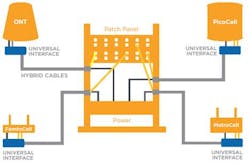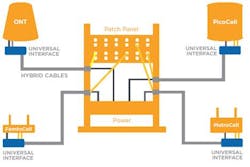By RYAN CHAPPELL, TE Connectivity -- One of the big challenges to deploying small cells, HD CCTV cameras, digital signage, Wi-Fi hotspots, and other remote devices is finding a local source of power for them.
Network engineers may have a plan for where they want to place these devices, but the absence of a local power source sometimes forces placement in alternative locations, or it means hiring an electrician to bring power to the remote device’s location.
Today, there are two alternatives to addressing this challenge: powered fiber cable and Power over Ethernet (PoE). In this article, we’ll look at powered fiber cable and PoE, and we’ll also take a look at the Carrier Ethernet 2.0 standard that enables service providers to deliver Ethernet over their infrastructure.
The challenge of remote power
Obtaining access to local power is a difficult and time-consuming process. For example, a major mobile operator may be planning a small cell deployment to supplement 4G services. The problem is access to power.
The carrier must negotiate access to local power with building owners and utility companies for wall- or pole-mounted small cells. Some utility companies and building owners want the carrier to put electrical meters on each small cell so the meters could later be read and the electric bill paid each month.
Even without the need for meters, the negotiations about access to power can take weeks or months, requiring the planning team to make phone calls, visit sites, etc. Once access to power is negotiated, the carrier must deploy electricians to the sites to bring power to the remote small cell or other device. This takes time and adds to the cost of deployment.
An elegant solution to this problem is to deploy power at the same time as connectivity. This requires a hybrid cable that combines communications with an electrical supply. By delivering power with connectivity, the network operator eliminates the need to negotiate local power for remote devices. Moreover, the hybrid cable can also eliminate the need for an electrician if the cable has plug-in connectors.
Carrier Ethernet 2.0 enables key applications from cloud services to mobile backhaul over all technologies using traditional or SDN approaches. On its face, CE 2.0 is a service delivery standard, and does not address the need for local power at the remote equipment site. For example, CE 2.0 has been used to backhaul traffic from small cells, but it does not generally provide power for those small cells.
However, when transported over powered fiber cable, the CE 2.0 protocol stands to provide the best of both worlds: it delivers carrier services with class of service, interconnect, and manageability, and would deliver power to remote locations, so that providing local power is no longer a problem.
RYAN CHAPPELL is global business development manager, optical cabling, at TE Connectivity. He began in the optics industry in 1994. Ryan has held various roles with multiple companies in research and development, engineering, marketing, and sales of optical cable, optical fiber, and other components of optical cable.
About the Author
Matt Vincent
Senior Editor
Matt Vincent is a B2B technology journalist, editor and content producer with over 15 years of experience, specializing in the full range of media content production and management, as well as SEO and social media engagement best practices, for both Cabling Installation & Maintenance magazine and its website CablingInstall.com. He currently provides trade show, company, executive and field technology trend coverage for the ICT structured cabling, telecommunications networking, data center, IP physical security, and professional AV vertical market segments. Email: [email protected]


